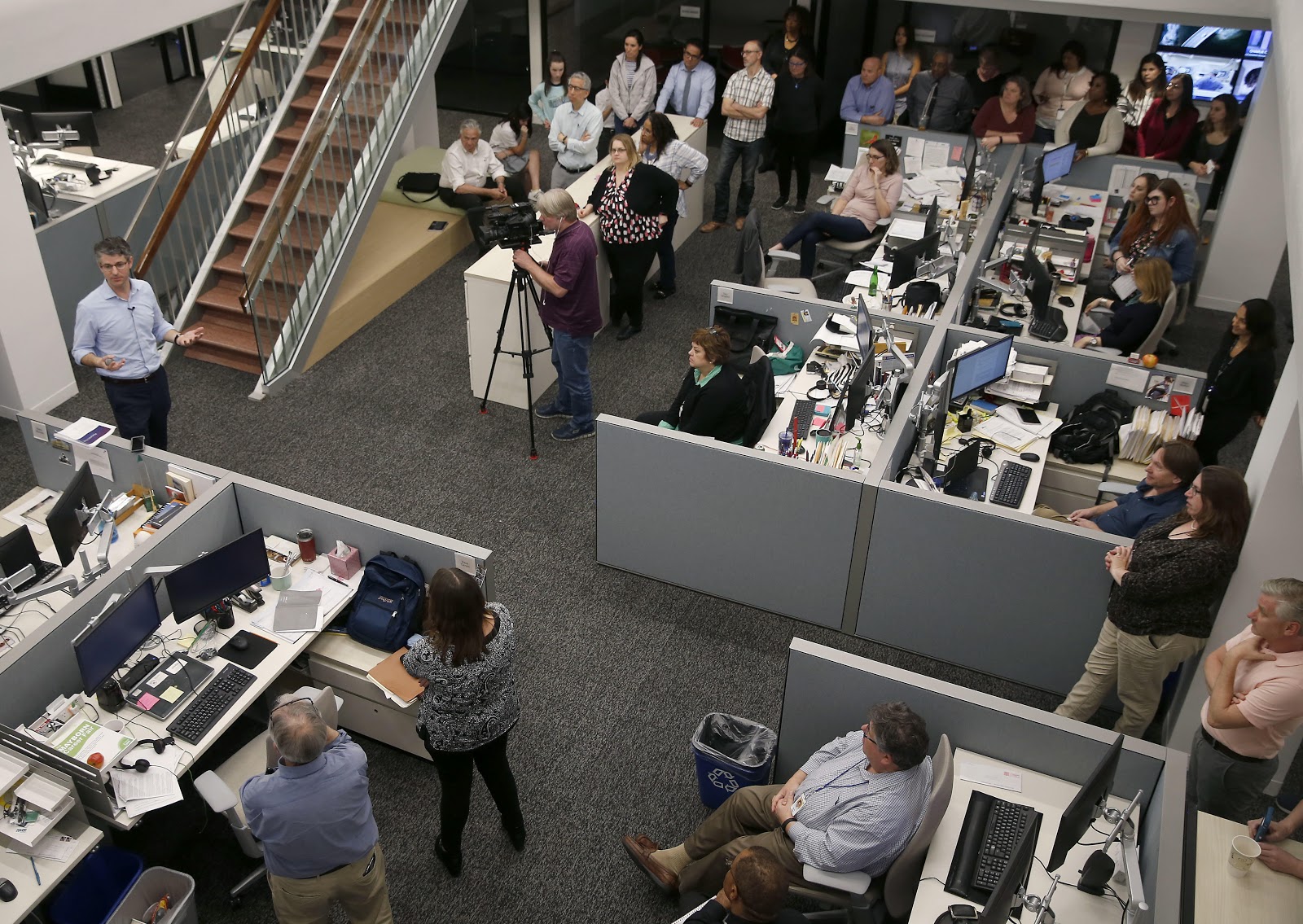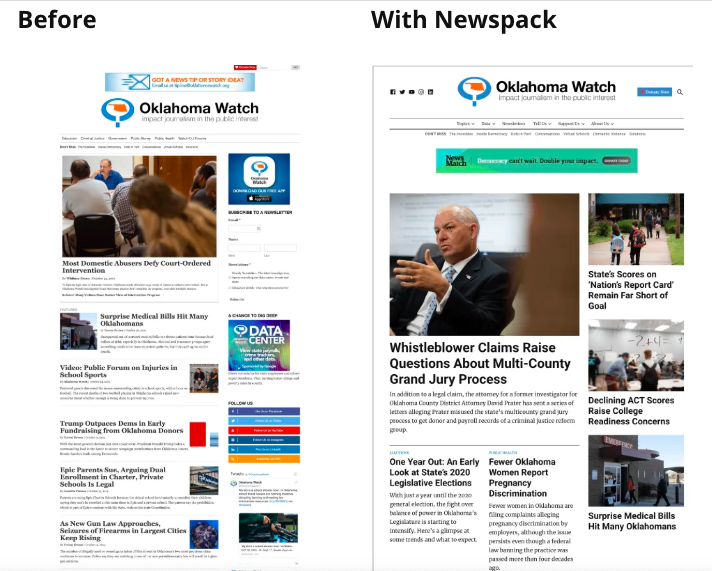Even if you hate it, you’re probably pretty comfortable with the system you use to publish news.
You’ve figured out the workarounds. You know the peccadillos. And that last CMS transition was rough, remember?
Cool. Ready to move again?
“It’s an overwhelming thought,” said Steve Beatty, who works in communications with Newspack, a publishing platform from WordPress. “Most of the time, I think journalists are happy with the devil they know.”
So why make the switch?
“CMS is destiny,” said Damon Kiesow, Knight Chair in digital editing and producing at the Missouri School of Journalism. “Pretty much everything you do in your entire organization, be it newsroom, advertising, subscriptions, video, AR – whatever the new thing is or the old thing is – that’s all constrained by the capacity or lack thereof of your content creation and publishing systems.”
There are now publishing platforms built by and for digital newsrooms both big and small. Journalists in different cities and from different companies are helping each other understand and use those platforms. And now, there’s a grant aimed at helping nonprofit newsrooms and newsrooms that cover underserved communities make the move. (It’s up to $20,000 for 25 newsrooms. See the details here.)
The biggest reason to make that move has to do with your current CMS, which “more than likely doesn’t allow the flexibility to be innovative,” Kiesow said, “and that innovation isn’t just editorial. It’s business, it’s audience engagement, it’s editorial storytelling.”
But moving to a new publishing platform is not necessarily:
- The same as a site redesign.
- Easy.
- Just about technology.
“This is not just moving from Android to Apple or one format to another or changing the browser you’re using,” said Merrill Brown, founder and CEO of The News Project. “It is about the fundamentals of what someone running a site is actually trying to do … It’s thought of as a technology opportunity, and certainly the technology is critical, but it’s really a product and business opportunity.”
Among what new publishing platforms promise:
- Faster load times
- Increased opportunities to grow subscribers and members
- Better storytelling opportunities
- Better user experience
And the process itself puts a spotlight on workflow, company goals and culture – the big picture stuff.
So what do you need to know before choosing a new CMS?
We spoke with three local newsrooms and four publishing platforms to find out. We also provide details — not reviews — on five different CMS platforms that many newsrooms are using (including their prices.) You can sign up for open demos, and send your questions for the platforms and the journalists using them. We’ve partnered with News Catalyst for this project and will round up answers.
Still not sure it’s worth the trouble? How about this: “Companies are asking journalists to do more with less resources,” said Scot Gillespie, general manager of The Washington Post’s Arc. “The only way you can do that is with emerging technology so you don’t run yourself into the ground.”

Don’t make these mistakes
Two years ago, The Philadelphia Inquirer moved to ARC and went through a site redesign at the same time.
“I don’t recommend doing that,” said Jessica Parks, the Inquirer’s assistant managing editor for digital and managing producer.
After Oklahoma Watch’s executive editor saw that WordPress’ Newspack was looking for newsrooms to pilot on its platform, he applied on the day of the deadline.
“I just kind of jumped in,” David Fritze said.
That meant that once the process began, it took Fritze awhile to catch up.
And The Dallas Morning News moved fast to transition onto Arc.
“How’s this for a pithy maxim: Never underestimate the challenges of content migration,” said Nicole Stockdale, Dallas Morning News’ director of digital strategy. “With just a little longer runway, we could have been more deliberate with some decisions that affected the newsroom; it seems almost impossible to get that balance right.”
Here are some lessons learned from both newsrooms and publishing platforms:
Get everyone on the same page
Two things make the process of moving to a new CMS easier, said Arc’s Gillespie: Agreeing that the move is a priority and understanding why. That means across the company, from business to tech to editorial.
“What we see very often is we’re actually the ones that are bringing them together and driving those discussions and helping with change management.”
What are the goals everyone can agree on? Efficiency? Higher engagement and traffic? Subscription conversions? Design flexibility?
Define those things up front, Gillespie said, so you don’t get off course.
Many newsrooms see moving to a new CMS as complicated, disruptive and expensive, said Brown with The News Project.
“It’s rarely something planned.”
But there’s a strategy behind moving platforms, and it matters to the business as a whole.
“I guess the thing that’s most dangerous is thinking of this in isolation and not understanding how cross-disciplinary it is. This is not the newsroom’s project, this is not the tech group’s project, this is the company’s project.”
If the migration and redesign process is not a collaboration across the company, Brown said, it won’t be effective, efficient or productive.
“It’s time to make this a priority and realize you can’t afford not to be thinking about it.”
Ask for help
With whatever publishing platform your newsroom chooses, you likely won’t be the first newsroom ever to use it. So don’t try to figure everything out on your own, said Parks with the Inquirer.
“Don’t reinvent the wheel.”
Midsize and bigger newsrooms have likely already done research and development with a CMS. What works for them? What are the limitations? What’s the transition process like? What’s the code to make that really cool thing? What does the data show?
“Most of those organizations are happy to talk and share,” she said.
In fact, the Dallas Morning News and the Philadelphia Inquirer have talked and shared as Dallas moved to Arc after Philly did, Parks said, and the learning has gone both ways.
“They have figured out some things that we sort of moved on from and gave up on.”
This is a big benefit, said MU’s Kiesow.
“It’s a community effort and even if there’s only 15 other people using it … they’re solving the same problems you’re going to have, and you can benefit from their knowledge.”
There’s no switch to flip
Newsrooms typically don’t move to a new publishing platform in, say, an easy afternoon.
“It’s helpful to have expectations close to reality,” said Katrina Barlow, vice president of Chorus Business with Vox Media’s Chorus.
One of those expectations, she said, is that big changes don’t happen overnight. Moving to a new CMS involves examining workflow, culture and technology.
At minimum, she said, the process can take four months.
And that process is iterative, said Stockdale with the Dallas Morning News.
“Months in, we still have a few major components of our workflow that are less efficient than they were on the old CMS. But our newsroom realizes that we’re better off overall – and they are crazy creative with workarounds.”
The unknown unknowns
One of the biggest mistakes newsrooms make is relying too much on the publishing platform itself, said MU’s Kiesow.
“It’s the unknown unknowns that kill us, and it’s typically because we didn’t have the right technology experts on our own side to do the vetting.”
That might mean that when print is no longer the main focus of the publishing system, what happens to the e-edition the old system made? Or the automatic reports for advertisers?
What happens to the archives? What happens to the urls?
Newsrooms have to ask those questions and make their solutions a priority from the beginning. And they have to accept that, even if they’re working with a media organization with a publishing platform, they’re still outsourcing some of their innovation to a third party, Kiesow said.
“They’re a much better vendor than maybe your old one,” he said, “but they also will likely have competing priorities, which means (you should) retain expertise internally to be able to support and execute on outlier needs you have that no one else has.”

Ask these questions
How will this platform improve your company, and what is it improving?
That means understanding “first and foremost how the newsroom can improve their workflow and then how does the technology or the CMS platform help them do that,” said Gillespie from Arc.
Will this platform improve inefficiencies, including making it easier to publish quickly? Will it drive collaboration in the company? And ultimately, will it help more content get published?
“The reason that a lot of CMS transitions, especially in newsrooms, fail or are painful is they’re really not built to enable a newsroom,” Gillespie said.
More from Poynter and News Catalyst: How to get a new CMS: A guide
What are you trading?
Most publishing platforms aim to increase page load speed, create a better customer experience and create better back-end integration. But for the user in the newsroom, Parks said, it might be harder to write a story. Be prepared for some trade-offs.
How will this create a better customer experience?
“Try to understand what readers expect from a modern news site,” said Beatty with Newspack. “Are you delivering that? I think today people have little patience for slow loading times.”
How does this create new revenue opportunities?
“What is our product direction?” asked Brown from The News Project. “How are we thinking of our site in the context of product development and what these changes mean for building a new plan or implementing our existing one?”
What happens when stuff goes wrong?
And how big is the existing community of users to turn to for help?
What does success look like?
And how will you measure it? asked Oklahoma Watch’s Fritze.
A new look is fairly straightforward. If it’s raising revenue, a new CMS alone won’t do that.
“You can’t just stick a donate form on the homepage and expect to raise $50,000.”
Also, don’t forget all the other things that factor into success – big stories, a social media plan, community outreach. It all has to work together.

You still gotta fish
“There’s not a journalist out there who enjoys learning a new computer system,” said Beatty with Newspack. “They want to be out there committing journalism.”
So why do all this?
Since moving to a new CMS, Oklahoma Watch’s site is definitely faster, Fritze said. It’s also livelier and offers a more compelling way to display content, including projects. His team now has quick access to analytics.
The Philadelphia Inquirer has been able to create easy-to-use templates for custom presentations and data visualizations that more people can use, and it has a video platform the newsroom didn’t have before. Also, Parks said, SEO and page load times are dramatically better.
And in Dallas, the new site and CMS load time is 10 times faster, Stockdale said. In the first three months, user sessions went up 26%, new users went up 29% and users viewing three or more pages went up 15%.
But the work isn’t over after the transition is complete.
The process gave Oklahoma Watch a much better website and potential, Fritze said, and now his newsroom has to take the time to figure out how to best use it.
“I do feel like as a small nonprofit news site, we have been delivered to the doorstep of a kind of wonderland, and now we must figure out how to best use all of the new tools and options.”
Chorus’ Barlow put what has to happen post-launch like this:
“You’re suddenly getting like the world’s best fishing rod,” she said. “But that still means you have to put on waders, get in the stream and actually catch a fish.”
Kristen Hare covers the transformation of local news for Poynter.org. She can be reached at khare@poynter.org or on Twitter at @kristenhare







